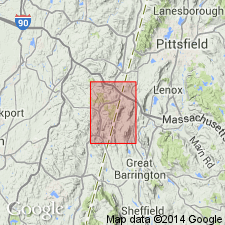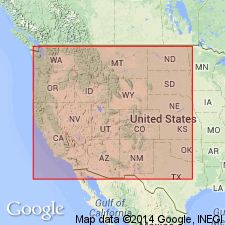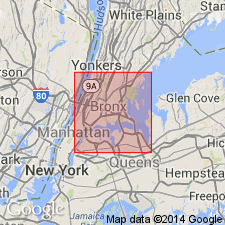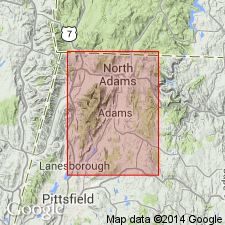
- Usage in publication:
-
- Walloomsac Formation*
- Modifications:
-
- Age modified
- Biostratigraphic dating
- AAPG geologic province:
-
- New England province
Summary:
Walloomsac Formation. Conodonts [ICRIODELLA SUPERBA, PHRAGMODUS UNDATUS, AMORPHOGNATHUS ORDOVICICUS] from basal limestone of Walloomsac Formation, exposed near No Bottom Pond (geologic map fossil loc. F1), indicate a Middle Ordovician or slightly younger age [J.W. Huddle, USGS, written commun., July 16, 1968; USGS fossil loc. 6307-CO]. Near western edge of quadrangle, along Dugway Road (geologic map fossil loc. F2), basal limestone of Walloomsac contains pelmatozoans, bryozoans, algae remains. Age of Walloomsac is considered Middle and Late(?) Ordovician.
[GNC remark (ca. 2020): Due to changes in the geologic time scale, the Walloomsac Formation is now considered Late Ordovician.]
Source: Publication.

- Usage in publication:
-
- Walloomsac Formation*
- Modifications:
-
- Geochronologic dating
- AAPG geologic province:
-
- New England province
Summary:
Pg. 15, geologic time scale (inside front cover). Walloomsac Formation (Middle Ordovician). Sample from staurolite-garnet schist, at Lat. 41 deg. 59 min. 45 sec. N., Long. 73 deg. 25 min. 00 sec. W., Sharon quadrangle, Litchfield County, Connecticut, yielded a Rb-Sr age of 368 +/-19 Ma (biotite). Age recalculated, using decay constants of Steiger and Jager, 1977 (Earth Planet. Sci. Letters, v. 36, p. 359-362), from Zen and Hartshorn's (1966) published age of 355 Ma for this sample. Zartman and others (1970) reported a K-Ar age of 390 Ma (muscovite). Initial age of schist (Middle Ordovician) disturbed by later metamorphism [Devonian].
Source: Publication.

- Usage in publication:
-
- Walloomsac Formation*
- Modifications:
-
- Overview
- AAPG geologic province:
-
- New England province
Summary:
Used as Walloomsac Formation of Middle Ordovician age. Mapped as one main unit and three informal, unnamed subunits. Subunit consisting of tan to dark-blue laminated quartzite and calcareous quartzite was previously mapped by other workers as Bellowspipe Quartzite [name not used on this map].
Source: GNU records (USGS DDS-6; Reston GNULEX).

- Usage in publication:
-
- Walloomsac Formation*
- Modifications:
-
- Revised
- Areal extent
Summary:
In this map area, Manhattan Schist member A is replaced by Walloomsac Formation based on work by Jackson and Hall (1982), Hall (in press), and A.A. Drake (1990., pers. commun.).
Source: GNU records (USGS DDS-6; Reston GNULEX).

- Usage in publication:
-
- Walloomsac Formation*
- Modifications:
-
- Age modified
- Biostratigraphic dating
- AAPG geologic province:
-
- New England province
Summary:
Thin limestone unit near base of Walloomsac locally contains abundant bryozoan fragments, cup corals, pelmatozoan hash, and conodonts that indicate that the base of the Walloomsac is Rocklandian (middle and late Caradocian) or younger. Age of unit is Middle Ordovician.
Source: GNU records (USGS DDS-6; Reston GNULEX).
For more information, please contact Nancy Stamm, Geologic Names Committee Secretary.
Asterisk (*) indicates published by U.S. Geological Survey authors.
"No current usage" (†) implies that a name has been abandoned or has fallen into disuse. Former usage and, if known, replacement name given in parentheses ( ).
Slash (/) indicates name conflicts with nomenclatural guidelines (CSN, 1933; ACSN, 1961, 1970; NACSN, 1983, 2005, 2021). May be explained within brackets ([ ]).

